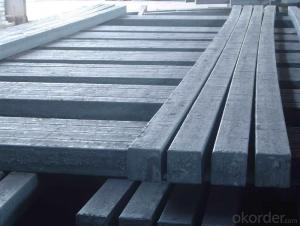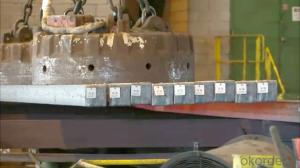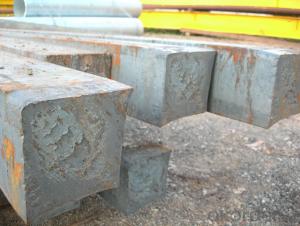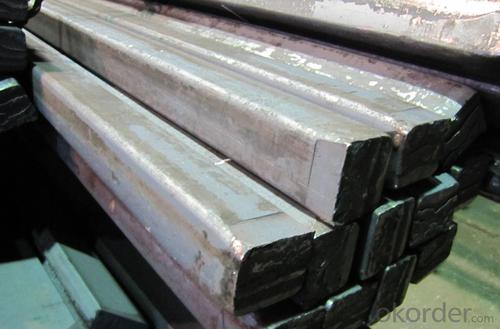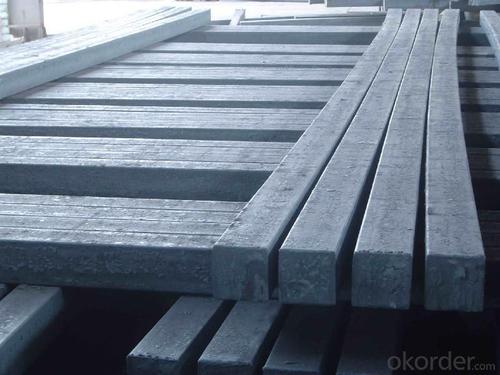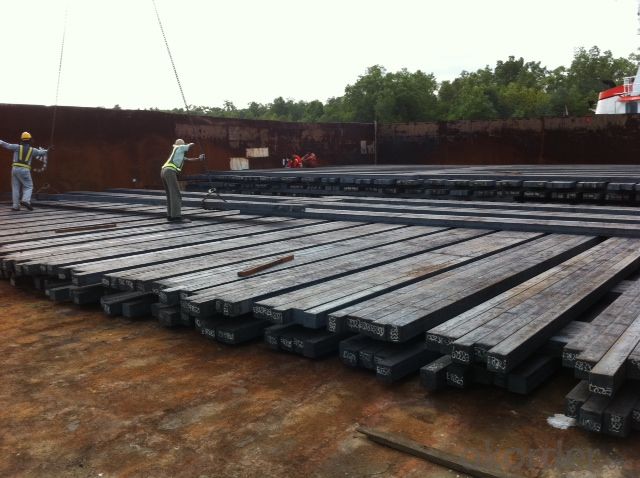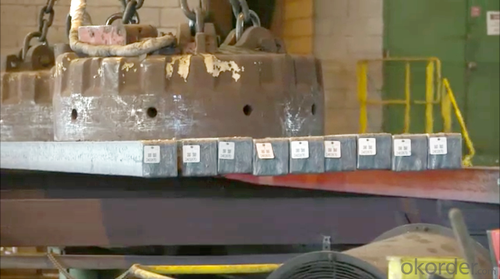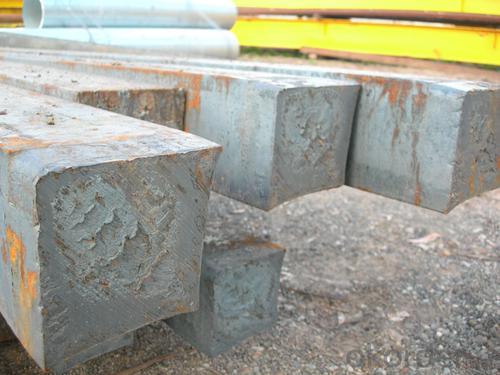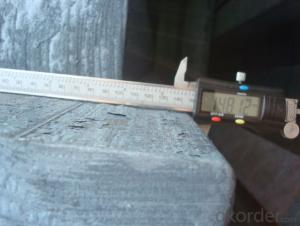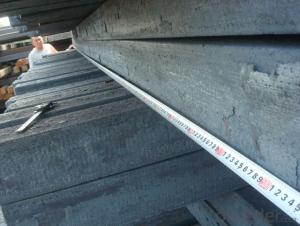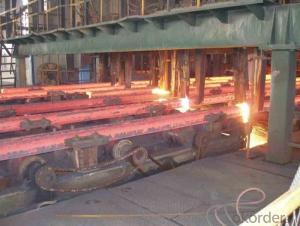Prime square alloy steel billet 160mm Q235
- Loading Port:
- Shanghai
- Payment Terms:
- TT OR LC
- Min Order Qty:
- 100 m.t.
- Supply Capability:
- 10000 m.t./month
OKorder Service Pledge
OKorder Financial Service
You Might Also Like
Structure of Prime square alloy steel billet 160mm Q235

Description of Prime square alloy steel billet 160mm Q235
1) Excellent corrosion resistance: The zinc layer provides a good protection of Pre-painted Galvanizeed Steel Sheet.
2) High heat resistance: The reflective surface of the material aids in efficiently reflecting the sunlight away and in turn reducing the amount of heat transmitted. The thermal reflectivity converts into energy savings.
3) Aesthetics: Pre-Painted Galvanized steel sheet is available in plethora of patterns and multiple sizes as per the requirements that given by our customers.
4) Versatility: can be used in the various areas.

Main Feature of Prime square alloy steel billet 160mm Q235
Uncoated CR steel sheet
With the features of in line with the international highest standards in demension and shape, excellent surface finish and properties, the products are mainly used in home appliance and automobile industries.
Galvanized steel sheet(include HDG and EG)
With the features of good corrosion resistance, the products are mainly used in automobile, home appliance, electronics, building and machinery manufacture industries, etc.
Precoated steel sheet
With the features of enviromental protection and good processablility, long lasting surface durability, rich in colors, the products are maily used in building, home appliance and furniture industries, etc.
Applications of Prime square alloy steel billet 160mm Q235
1) Excellent corrosion resistance: The zinc layer provides a good protection of Pre-painted Galvanizeed Steel Sheet.
2) High heat resistance: The reflective surface of the material aids in efficiently reflecting the sunlight away and in turn reducing the amount of heat transmitted. The thermal reflectivity converts into energy savings.
3) Aesthetics: Pre-Painted Galvanized steel sheet is available in plethora of patterns and multiple sizes as per the requirements that given by our customers.
4) Versatility: can be used in the various areas.

Specifications of Prime square alloy steel billet 160mm Q235
Product | Billet |
Material Grade | SGCC / SGCH / DX51D+AZ, etc |
Thickness | 0.6-3.0mm |
Width | 500-1500mm |
Tolerance | Thickness: +/-0.02mm , Width:+/-2mm |
Zinc-coating | Z30-150g/m2 |
Technique | Raw material: Hot rolled steel coil --> Cold rolled_>hot dipped galvalume |
Surface | Dried, Chromated, Unoiled |
Spangle | Regular spangle , small spangle, zero spangle |
ID | 508MM 610MM |
Coil weight | 1-25MT |
Export package | Cardboard inner sleeves, Waterproof paper, galvanized steel covered and steel strip packed |
FAQ of Prime square alloy steel billet 160mm Q235
We have organized several common questions for our clients,may help you sincerely:
1. How Can I Visit There?
Our company is located in Tianjin City, China, near Beijing. You can fly to Tianjin Airport Directly. All our clients, from home or aboard, are warmly welcome to visit us!
2. How Can I Get Some Sample?
We are honored to offer you sample.
3. Why choose CNBM?
we always fix steel produce in container well to make it safe arrive at destination port
we always provide best and professional forward service for our buyer
we always apply 14days free detention for our buyers container in destination
we provide one set After-sales service for our buyer
we provide China inland steel market price report
we help our buyer become number one in local market .
- Q: What are the specifications for tool steel billets used in the automotive industry?
- Tool steel billets used in the automotive industry typically have specific specifications to ensure their suitability for various applications. These specifications are crucial to ensure the desired performance and durability of the tool steel in automotive manufacturing processes. One important specification for tool steel billets used in the automotive industry is the chemical composition. The tool steel must have a specific composition of elements such as carbon, chromium, vanadium, and molybdenum, among others. These elements contribute to the steel's hardness, wear resistance, and toughness, which are essential properties for automotive tooling. Additionally, the tool steel billets must possess a specific hardness range. Hardness is measured using various scales such as Rockwell or Brinell, and the desired hardness depends on the intended application. Higher hardness is generally preferred for tools that require high wear resistance, while lower hardness may be suitable for tools that require toughness and impact resistance. Furthermore, the tool steel billets used in the automotive industry must have excellent dimensional stability. This means that the steel should have minimal dimensional changes during heat treatment and manufacturing processes, ensuring the tools maintain their shape and accuracy over time. Another important specification is the machinability of the tool steel. It should be easy to machine and shape into the desired tooling components without excessive tool wear or difficulty. Good machinability allows for efficient production and reduces costs associated with tooling. The tool steel billets used in the automotive industry should also have good thermal conductivity. This property allows the heat generated during manufacturing processes, such as forging or heat treatment, to be effectively dissipated. Good thermal conductivity helps prevent localized overheating and ensures uniform heat distribution throughout the tool, resulting in consistent performance. Lastly, the tool steel billets should be free from defects and impurities. These include cracks, voids, inclusions, or any other imperfections that can compromise the integrity and performance of the tool steel. Quality control measures, such as non-destructive testing, are typically implemented to ensure the billets meet the required standards. In summary, the specifications for tool steel billets used in the automotive industry encompass factors such as chemical composition, hardness, dimensional stability, machinability, thermal conductivity, and overall quality. These specifications ensure that the tool steel meets the specific requirements of automotive tooling applications, providing durability, performance, and reliability in automotive manufacturing processes.
- Q: How do steel billets contribute to the manufacturing of kitchen appliances?
- Kitchen appliances rely on steel billets as an essential component for their production. These semi-finished steel products, typically rectangular or square in shape, are created through continuous casting. One way in which steel billets contribute to the manufacturing of kitchen appliances is by serving as the primary raw material for various appliance components. Stoves, ovens, refrigerators, and dishwashers require a strong and durable structure, which steel billets provide. Through processes like hot rolling, forging, or extrusion, the billets are transformed into specific parts such as frames, doors, panels, and handles. Steel billets also play a vital role in ensuring the longevity and reliability of kitchen appliances. With its high tensile strength and resistance to corrosion, steel allows manufacturers to create appliances that can withstand daily use and endure for a long time. By using steel billets as the base material, kitchen appliances can handle high temperatures, heavy loads, and harsh environments without compromising their structural integrity. Moreover, steel billets contribute to the aesthetic appeal of kitchen appliances. The smooth and polished surface of steel provides an attractive and modern finish, making appliances visually appealing to consumers. Steel can also be easily manipulated to achieve different shapes and designs, allowing manufacturers to create sleek and stylish appliances that complement the overall kitchen decor. Additionally, steel billets possess excellent heat conductivity properties, which is crucial for kitchen appliances like stoves and ovens. The even distribution of heat throughout the appliance ensures efficient cooking and baking, guaranteeing that food is cooked thoroughly and evenly. In conclusion, steel billets are indispensable in the manufacturing of kitchen appliances due to their strength, durability, aesthetics, and heat conductivity properties. Without these billets, it would be challenging to produce high-quality, reliable, and visually appealing kitchen appliances that meet consumer demands.
- Q: What are the different surface treatments for corrosion resistance in steel billets?
- There are several surface treatments available for enhancing corrosion resistance in steel billets. These treatments are crucial in preventing the formation of rust and oxidation, which can significantly deteriorate the quality and lifespan of the steel billets. Some of the commonly used surface treatments for corrosion resistance in steel billets include: 1. Hot-dip galvanizing: This process involves immersing the steel billets in a bath of molten zinc, forming a protective coating on the surface. The zinc coating acts as a sacrificial layer, shielding the steel from corrosion. 2. Electroplating: This method involves depositing a thin layer of a corrosion-resistant metal, such as nickel or chromium, onto the steel billet's surface using an electrochemical process. The plated metal acts as a barrier, preventing direct contact between the steel and corrosive agents. 3. Passivation: This treatment involves treating the steel surface with chemicals, typically an acid solution, to remove any impurities or contaminants that may promote corrosion. Passivation creates a passive oxide layer on the surface, which provides corrosion resistance. 4. Powder coating: In this process, a dry powder is applied to the steel billet's surface electrostatically and then cured under heat. The powder melts and forms a protective layer on the steel, which offers excellent corrosion resistance. 5. Organic coatings: These coatings, such as paints or varnishes, are applied to the steel billet's surface. They provide a protective barrier against moisture and corrosive agents. Organic coatings can be customized to meet specific requirements in terms of color, texture, and durability. 6. Anodizing: This treatment is typically used for aluminum or aluminum alloy steel billets. It involves creating an oxide layer on the surface by subjecting it to an electrochemical process. The resulting anodized layer enhances corrosion resistance and also provides an aesthetic appearance. It is important to choose the appropriate surface treatment based on the specific requirements of the steel billets, considering factors such as the intended application, environmental conditions, and expected lifespan. Regular maintenance and periodic reapplication of the surface treatment may also be necessary to ensure continued corrosion resistance.
- Q: How are steel billets used in the production of railway tracks?
- Steel billets are the raw materials used in the production of railway tracks. They are heated, shaped, and rolled to form long, flat bars known as rails. These rails are then laid on the trackbed, forming the foundation for the tracks on which trains run.
- Q: How are steel billets inspected for hardness?
- Steel billets are inspected for hardness using a variety of methods and techniques. One of the commonly used methods is the Rockwell hardness test. This test measures the depth of penetration of an indenter into the steel surface under a specific load. The hardness value is then determined based on the depth of penetration. The Rockwell hardness test provides a quick and reliable way to assess the hardness of steel billets. Another method used for hardness inspection is the Brinell hardness test. This test involves applying a specific load on a hardened steel ball and measuring the diameter of the indentation left on the steel surface. The hardness value is calculated based on the applied load and the diameter of the indentation. The Brinell hardness test is useful for large steel billets or when a larger area needs to be tested. Furthermore, Vickers hardness test can also be employed for inspecting the hardness of steel billets. This method utilizes a diamond pyramid-shaped indenter to create an impression on the steel surface. The diagonals of the impression are measured, and the hardness value is determined based on the applied load and the surface area of the impression. The Vickers hardness test is commonly used for materials with high hardness or small components. In addition to these traditional hardness testing methods, there are also advanced techniques available, such as ultrasonic testing and magnetic induction. Ultrasonic testing involves sending high-frequency sound waves through the steel billet and measuring the time it takes for the waves to be reflected back. Any variations in the hardness of the billet can be detected through changes in the ultrasonic waves. Magnetic induction, on the other hand, utilizes magnetic fields to assess the hardness of steel. By measuring the electrical conductivity and permeability of the steel billet, the hardness can be estimated. Overall, there are several techniques available for inspecting the hardness of steel billets, including Rockwell, Brinell, Vickers hardness tests, as well as ultrasonic testing and magnetic induction. These methods provide valuable information about the hardness properties of the billets, allowing manufacturers to ensure the quality and suitability of the steel for various applications.
- Q: How are steel billets used in the manufacturing of rail tracks?
- Steel billets are used in the manufacturing of rail tracks as they serve as the raw material for the production of rails. These billets are heated and then rolled into the desired shape and size to create the rails. They provide the necessary strength, durability, and stability required to withstand the heavy loads and constant wear and tear experienced by rail tracks.
- Q: Can steel billets be used for making hand tools?
- Yes, steel billets can be used for making hand tools. Steel billets are the initial form of steel that can be shaped and processed into various products, including hand tools. The billets can be heated, forged, and machined to create durable and reliable hand tools that can withstand the rigors of daily use.
- Q: What is the lifespan of steel billets?
- The lifespan of steel billets can vary depending on various factors such as the quality of the steel, the conditions in which they are stored, and the specific application they are being used for. Generally, steel billets can have a relatively long lifespan if they are properly stored and maintained. In ideal conditions, steel billets can last for several years without any significant degradation. However, if the billets are exposed to harsh environmental factors such as moisture, extreme temperatures, or corrosive substances, their lifespan may be significantly reduced. It is important to handle and store steel billets carefully to minimize any potential damage and ensure their longevity.
- Q: What is Alfa carbon? What is beta carbon?
- Alfa is directly connected with the functional groups of carbon atoms of carbon atoms, such as CH3CH2COOH CH2 in which methylene propionate is Alfa carbon carbon carbon atom is the beta carbon atom is directly connected with the functional groups and the connection of the carbon (around Kazakhstan), such as the CH3CH2COOH CH3 propionic acid methyl carbon is the beta carbon
Send your message to us
Prime square alloy steel billet 160mm Q235
- Loading Port:
- Shanghai
- Payment Terms:
- TT OR LC
- Min Order Qty:
- 100 m.t.
- Supply Capability:
- 10000 m.t./month
OKorder Service Pledge
OKorder Financial Service
Similar products
Hot products
Hot Searches
Related keywords


